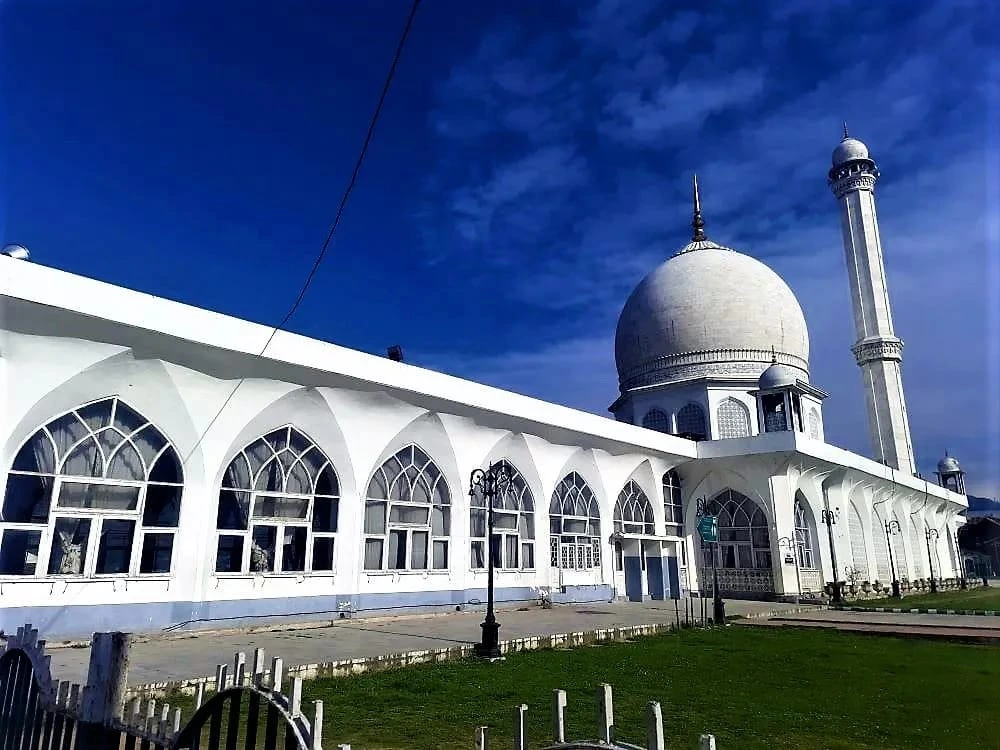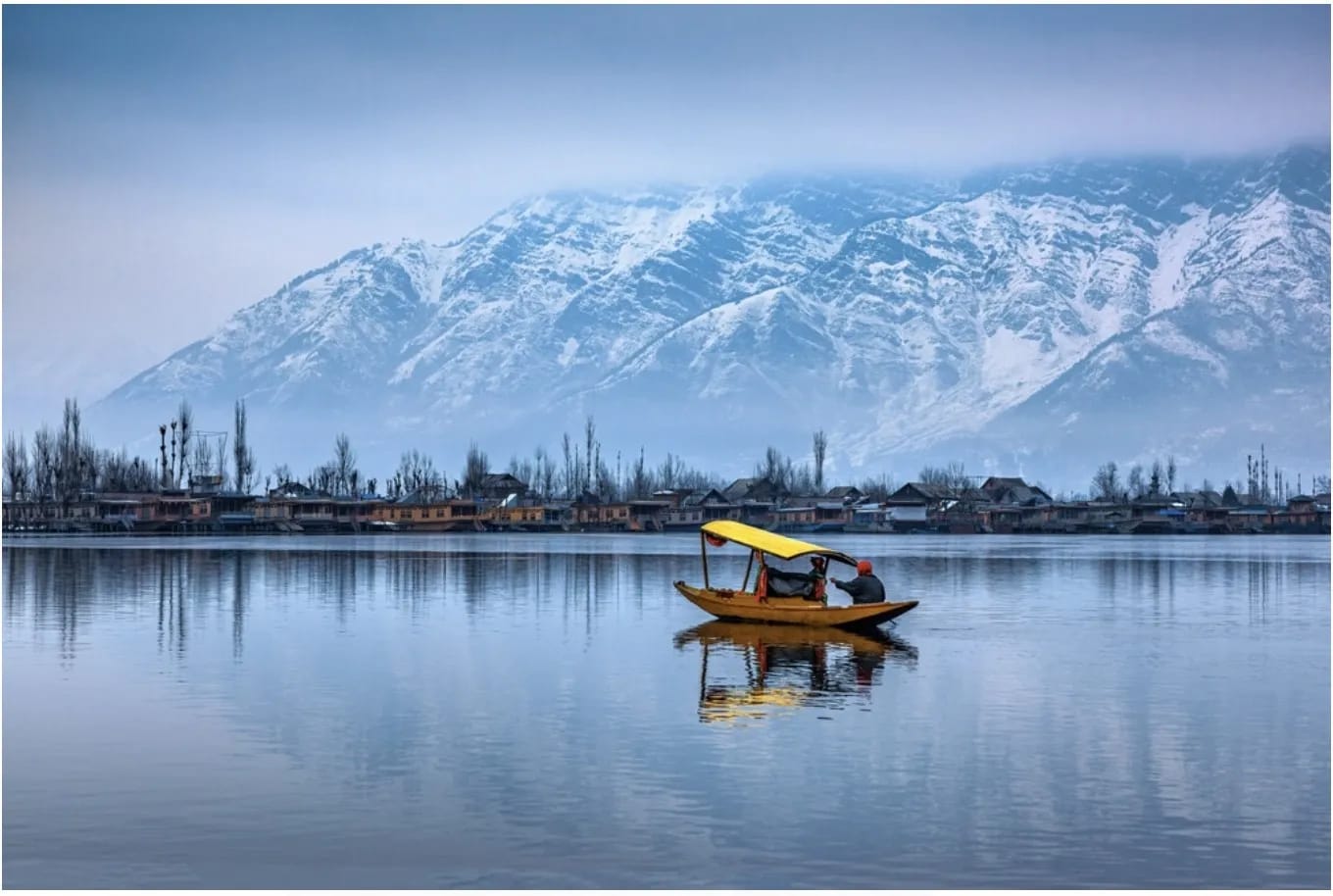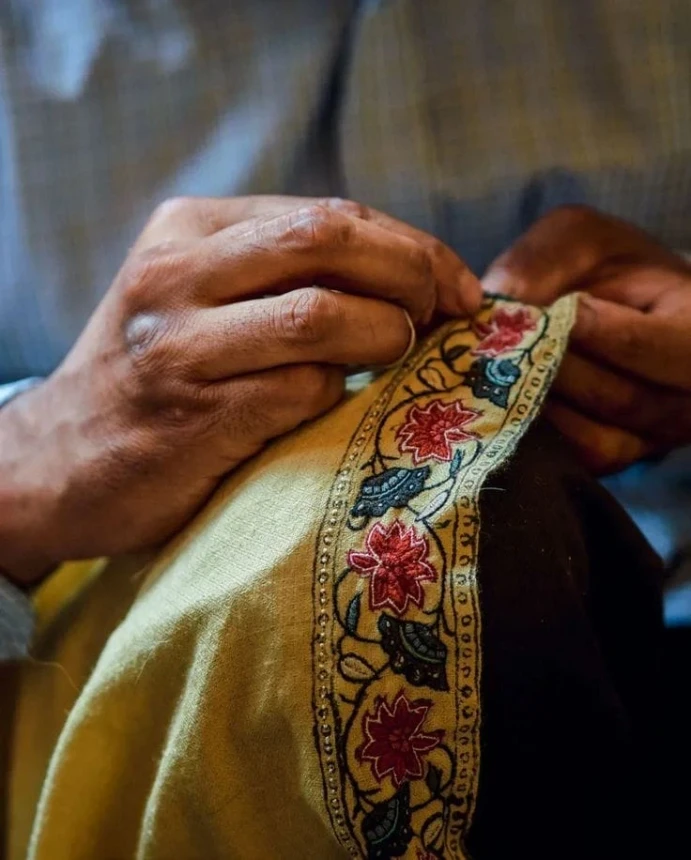Amidst the awe-inspiring beauty of the Himalayan landscape, Kashmir has been renowned for its mesmerising charm and diverse cultural heritage. Yet, beneath this picturesque exterior lies a heartrending truth- a sorrowful trail of disappearing customs that once defined the essence of this historic region.
With each passing day, Kashmir witnesses the slow erosion of its cherished culture, heritage, language, and culinary treasures. Centuries-old customs that once bound communities together are now slipping away into the sands of time. The vibrant threads of Kashmiri identity, woven delicately through generations, are now at risk of fraying.
“Kashmir is renowned as one of the most breathtaking places on earth, often called the crown of India. The origin of Kashmiri culture and heritage is a complex and multifaceted journey that spans thousands of years. The region of Kashmir has been a melting pot of various influences and civilisations, contributing to its unique cultural identity. It has a rich history dating back 5500 years, with 4000 years of Hindu rituals, customs, and the Sanskrit language being prevalent. This was followed by a 1200-year Buddhist period.”
Conservation of Heritage sites in India is important because:
Conservation of heritage sites and buildings provides a sense of identity and continuity in a fast-changing world. Heritage sites and buildings represent the past history and culture of a nation. It is important to support the tourism industry. A heritage site is a place that preserves the cultural, social, and political history of a place.
Plan your tour to the Kashmir valley to explore all these ancient monuments of Jammu & Kashmir. These landmarks indicate different history, represent the most beautiful Indian architecture, and offer an exquisite view of gardens & mountains.
Historical Background of Kashmir Monuments
Myth is deeply related to the cultural history of Kashmir. Since the beginning of Kashmir’s history, the myth (Purakatha) has held a great place. The origins of Kashmir, starting from the geographical location, the presence of public life, the construction of rivers, lakes, shrines, temples, mosques, and all matters of religious and societal transformation, are closely related to myth and legends. In some cases, the myths also focus on the views of the individual or the ruling classes. There are many myths, legends, and miraculous facts about the Rishi and Sufi saints in Kashmir.
Buddhism played a significant role in the traditional culture of Kashmir, as evidenced by the Nilamata Purana and Kalhana’s Rajatarangini. Although it was widespread in Kashmir long before Emperor Asoka’s time, and enjoyed the patronage not only of Buddhist rulers but also of Hindu rulers, it is generally believed that Buddhism did not become the dominant religion in Kashmir until the time of Emperor Ashoka. However, this is not the case. It began in Kashmir and quickly expanded to the surrounding regions of Ladakh, Tibet, and China.
The book known as the Rajatarangini, along with the writings of three Chinese travelers who travelled to Kashmir between the years 630 and 760 AD, both provide tales of the monarchs of Kashmir’s support of Buddhism. According to many Buddhist texts, the introduction of Buddhism to Kashmir can be traced back to Majjhantika, a monk from Varanasi who was also a pupil of Ananda. According to the Ceylonese Chronicle, after the Third Buddhist Council came to a close, Ashoka dispatched missionaries to various kingdoms so that Buddhism could be disseminated throughout the world.
Majjhantika was dispatched to Kashmir and Gandhara (modern day Afghanistan). The tale of Majjhantika can also be found recounted in a number of other Buddhist writings, including the Ashokavadana and the Avadanakalpalata, for example. The Buddhist literature known as the Divyavadana, on the other hand, claims that Emperor Ashoka summoned a number of monks from Kashmir to Patliputra (present day Patna, Bihar).
Following the decline of Buddhist influence, Kashmir saw the rise of powerful Hindu dynasties. The most notable among them was the Karkota dynasty, especially during the reign of Lalitaditya Muktapida (8th century CE). Under his rule, Kashmir witnessed a golden age of architecture, sculpture, and religious tolerance.
He is credited with constructing the famous Martand Sun Temple, one of the most iconic ancient Kashmir monuments, which reflects a blend of Gandharan, Gupta, and Kashmiri architectural styles. Later, the Utpala and Lohara dynasties continued to rule the region and patronized Shaivism and Vaishnavism. Numerous temples and shrines were built during this period, contributing to the region’s rich religious heritage.
Shankaracharya Temple: A Sacred Kashmir Monument Overlooking Srinagar
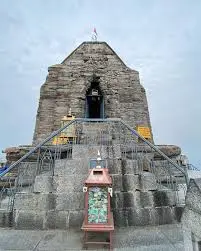
Sultan Sikandar, the ruler of Kashmir, destroyed the Shiva Lingam of the temple and several other idols of the Gods. Later, different rulers restored the temple at different times because of natural disasters and several attacks.
According to popular belief, several kings have repaired this temple over a period. The temple was rebuilt and renovated by King Godapatta in the first century AD, and he dedicated this temple to Jyeteshwara.
King Gopaditya (426-365 BC) and King Lalitaditya (697-734 AD) carried out later renovations. Gulab Singh of the Dogra dynasty renovated the Durga Naag shrine on its premises. The King of Mysore installed electric fittings in the temple in the modern period. In 1961, the Shankaracharya of Dwarkapeeth installed the statue of Adi Shankaracharya.
The current structure of the temple traces its origin to the 9th century AD during the reign of the Sikhs. It was when the Shivalinga was placed in the temple. The Sikh rulers revived the fortunes of this temple with regular prayers and festival celebrations.
The temple is also called Bagh-i-Sulaiman by the Jews and the Persian community. Evidence indicates that this temple belongs to ancient times, as scholars have found various Persian scriptures here.
Martand Sun Temple: Ancient Hindu legacy among Kashmiri Monuments
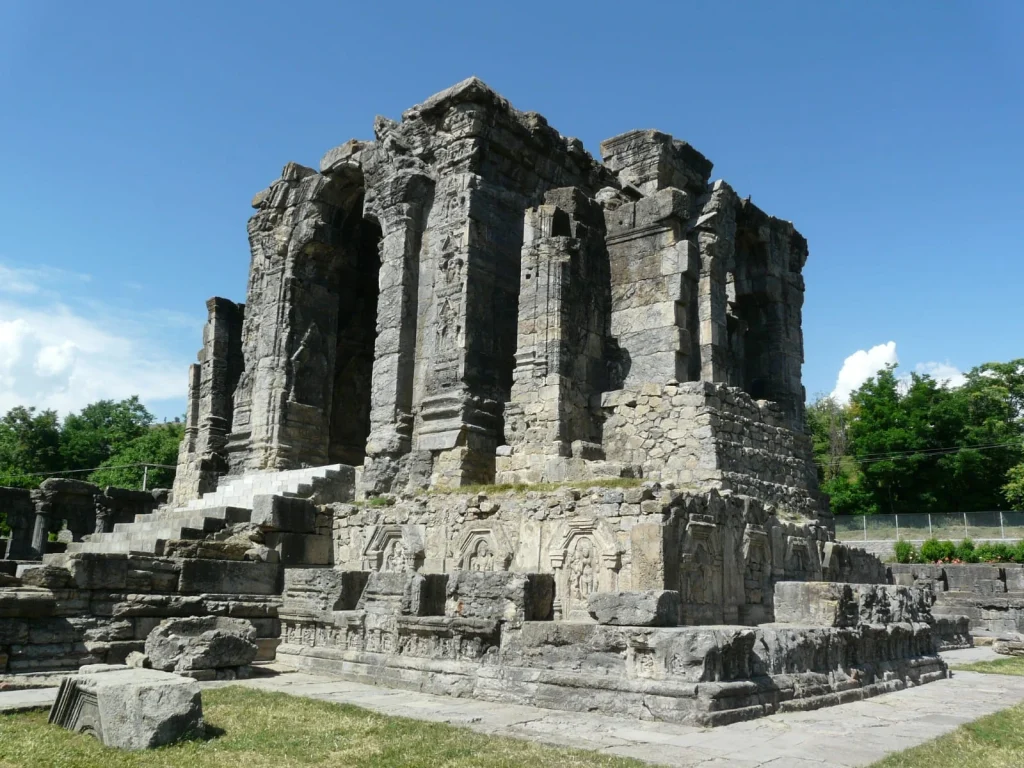
The Archaeological Survey of India has classified Martand Sun Temple with the recognition as an ASI-protected site. Anantnag town, located at an altitude of approximately 5,400 feet above sea level, seems to be approximately 33 miles from Srinagar and seems to be easily accessible by road.
The Martand temple is located on a plateau with a panoramic view of the entire Kashmir Valley. Dedicated to Vishnu-Surya, the Martand Temple has three distinct chambers—the mandapa, the garbhagriha, and the antralaya—probably the only three-chambered temple in Kashmir.
This is a columned medieval temple with a monument in the centre and a yard. It contains 84 column-like structures, which are a holy Hindu figure, and offers stunning views of the surrounding valleys.
This points to the position it enjoyed. The temple is built in a unique Kashmiri style. The temple is also influenced by Classical Greco-Roman, Buddhist-Gandhara, and North Indian styles.
The temple possesses far more imposing dimensions than any other existing temple, being 63 feet long. As an isolated ruin, this deserves on account of its solitary and massive grandeur, to be ranked, not only as the first ruin of the kind in Kashmir but as one of the noblest amongst the architectural relics of antiquity that are to be seen in any country.
The principal shrine is at the centre of a quadrangular courtyard, flanked towards the north and south by two small structures. The temple walls are built of huge blocks of evenly dressed grey limestone by making use of lime mortar.
The magnificent Martand Sun Temple, located amongst the woods in the region of Mattan within Kashmir’s Anantnag Province. It still makes for an impressive sight with the formidable grey walls standing stark against the blue sky, broken grey fragments strewn around the green grass. Some of the walls bear clear carvings of deities, and the beauty and symmetry of the temple are still amply evident. The temple is ringed by a row of pillars—the peristyle common in Kashmiri temple architecture.
Pari Mahal: A Mughal-Era Observatory And Kashmir Monument Of Learning
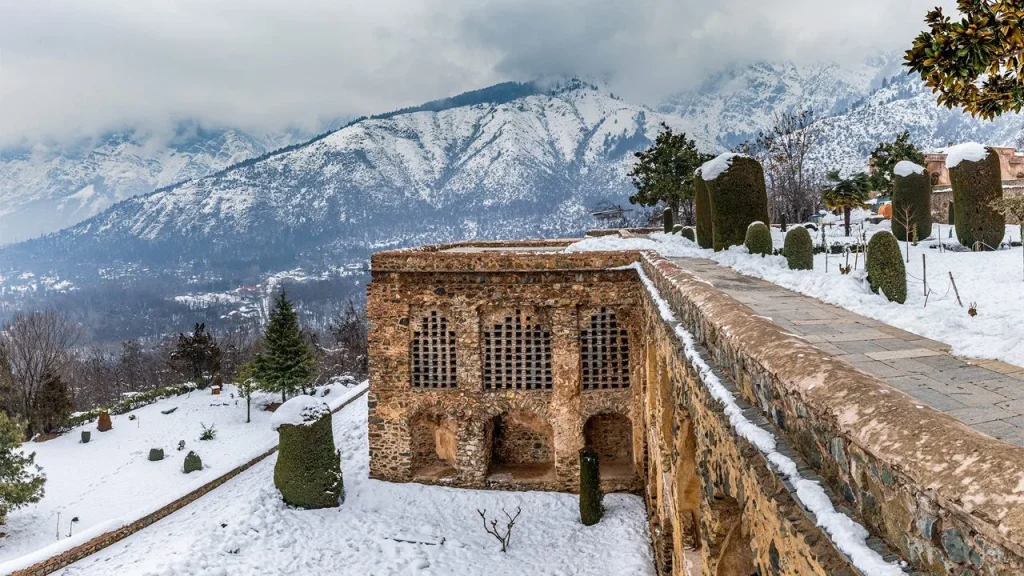
Pari Mahal or the abode of fairies sits majestically upon the slopes of the Zabarwan mountain range west of Chashma Shahi, around 13.2 km from the Srinagar city centre. It is a garden palace and its construction in mid- mid-1600s is ascribed to Dara Shikoh, the son of Mughal emperor Shah Jahan, who used to study astrology and astronomy here. Prince Dara had a great interest in mysticism, and he got the garden built for his Sufi tutor, Mullah Shah Badakhshi.
Like other gardens, it has attracted a huge number of tourists over the years for its mysterious yet tranquil ambience. However, unlike other Mughal gardens, it has no water cascades but used to have fountains fed through pipes and tanks made for that purpose.
Pari Mahal boasts of a unique architecture not found anywhere in the Valley of Kashmir and clearly depicts the immense patronage of art by the Mughal emperor Shah Jahan.
It consists of six terraces aligned roughly north-south, with the uppermost point at its southern end and arched retaining walls supporting the terraces against the mountain. The garden measures 122 meters by 62.5 meters.
Pari Mahal can be approached by a road that ends just at the main entrance of the garden. It is a ladder-shaped structure with six terraces. The terraces are accessed via sets of steps on their corners. Each flight of steps measures 6.7 m by 1.3 m. At the center of the sixth, or uppermost, terrace, a water tank with an arched wall is set against the mountain slope. From the sixth terrace, a baradari or pavilion overlooks the lower terraces.
After remaining in a state of ruin for many years, the garden has been thrown open for visitors after minor renovations. Visible from far away, the structure looks especially intriguing when floodlights are switched on at night. As it lies on the way to other Mughal gardens, it is a must-visit place when you are in Srinagar.
Hari Parbat Fort: A Historic Kashmir Monument Of Religious Harmony
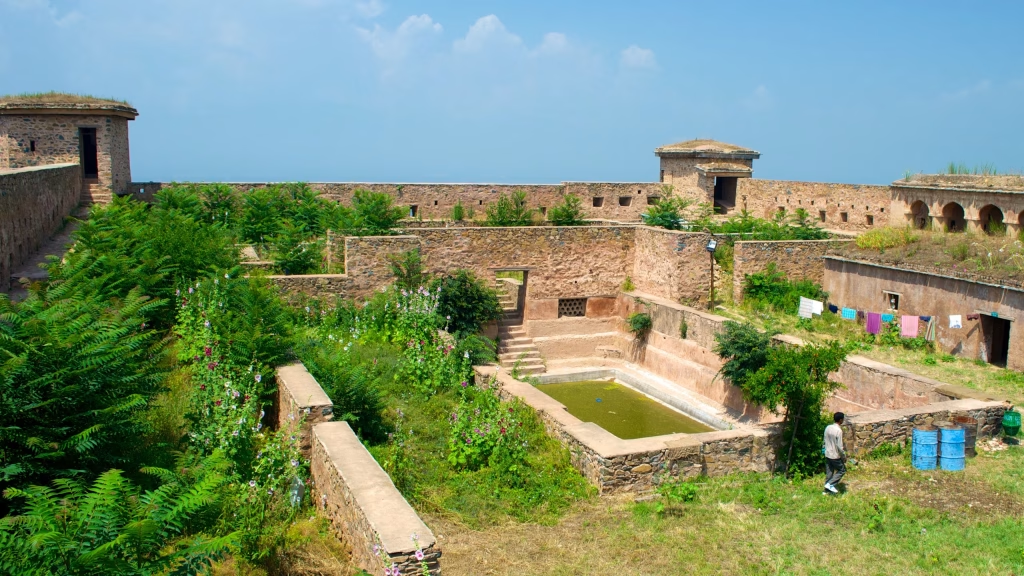
Hari Parbat, also called Koh-i-Maran, is a hill overlooking Srinagar, the largest city and summer capital of Jammu and Kashmir, India. It is the site of a fort, built in the Durrani era, and of a Hindu temple, mosques, and a gurdwara. The first fortifications on the site were constructed by the Mughal emperor Akbar in 1590, who built an outer wall for the fort as part of his plans for a new capital called Nager Nagor. The project, however, was never completed.
The present fort was built in 1808 under the reign of Governor Atta Mohammed Khan. Hari Parbat is considered sacred by the Kashmiri Pandits, who also call it Pradyumna Peeth. The hill hosts a temple of Shakti, who is worshipped there under the name Jagadamba Sharika Bhagawati. She is depicted as having 18 arms and sitting in Shri Chakra.

The southern side of Hari Parbat features Makhdoom Sahib, the shrine of Hamza Makhdoom, a 16th-century Kashmiri Sufi saint locally known as Hazrat Sultan and Sultan-ul-Arifeen. Built below the fort is a mosque dedicated to Shah Badakhshi, a 17th-century Qadiri Sufi saint. The mosque was built by Mughal princess Jahanara Begum.
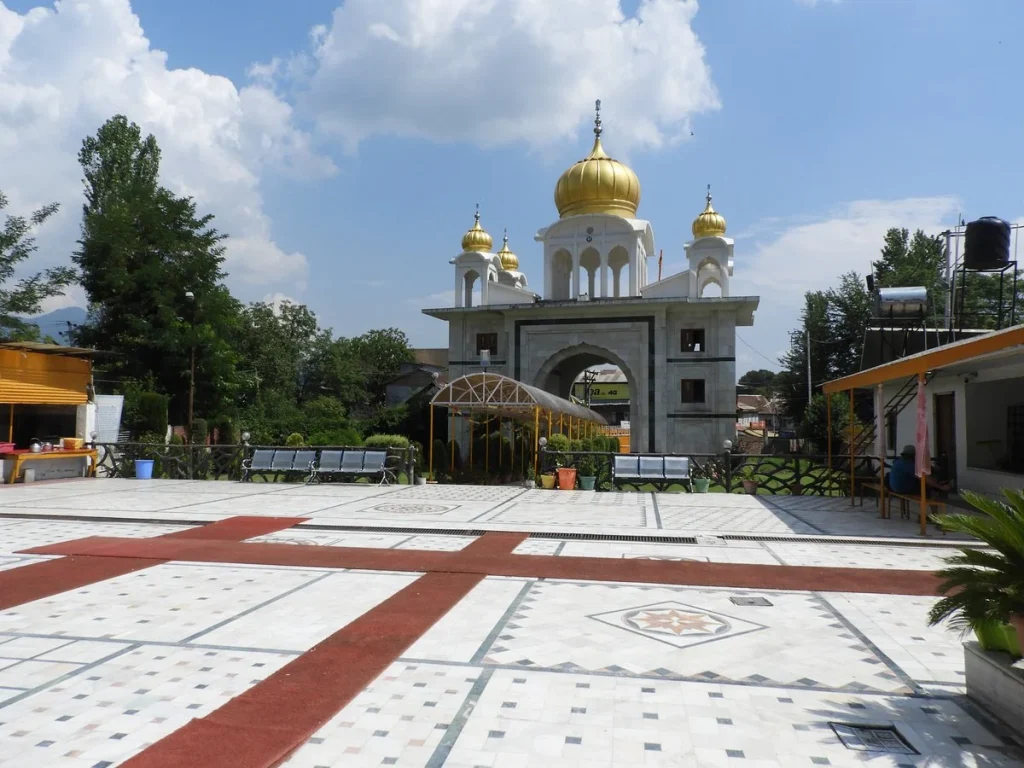
Gurdwara Chatti Patshahi at Kathi Darwaza, Rainwari, is believed to be the place where Guru Har Gobind, the sixth Sikh guru, stayed for a few days while travelling through Kashmir. Gurdwara Guru Nanak Dev is a place where Guru Nanak sat and had discourse with people in the early sixteenth century. It was earmarked with a pedestal by Mohammad Ata Khan, a general of Akbar, who built the Durrani Fort. A small Gurdwara was later built at the place by Guru Har Gobind.
Jamia Masjid: A Symbol Of Faith And Architecture
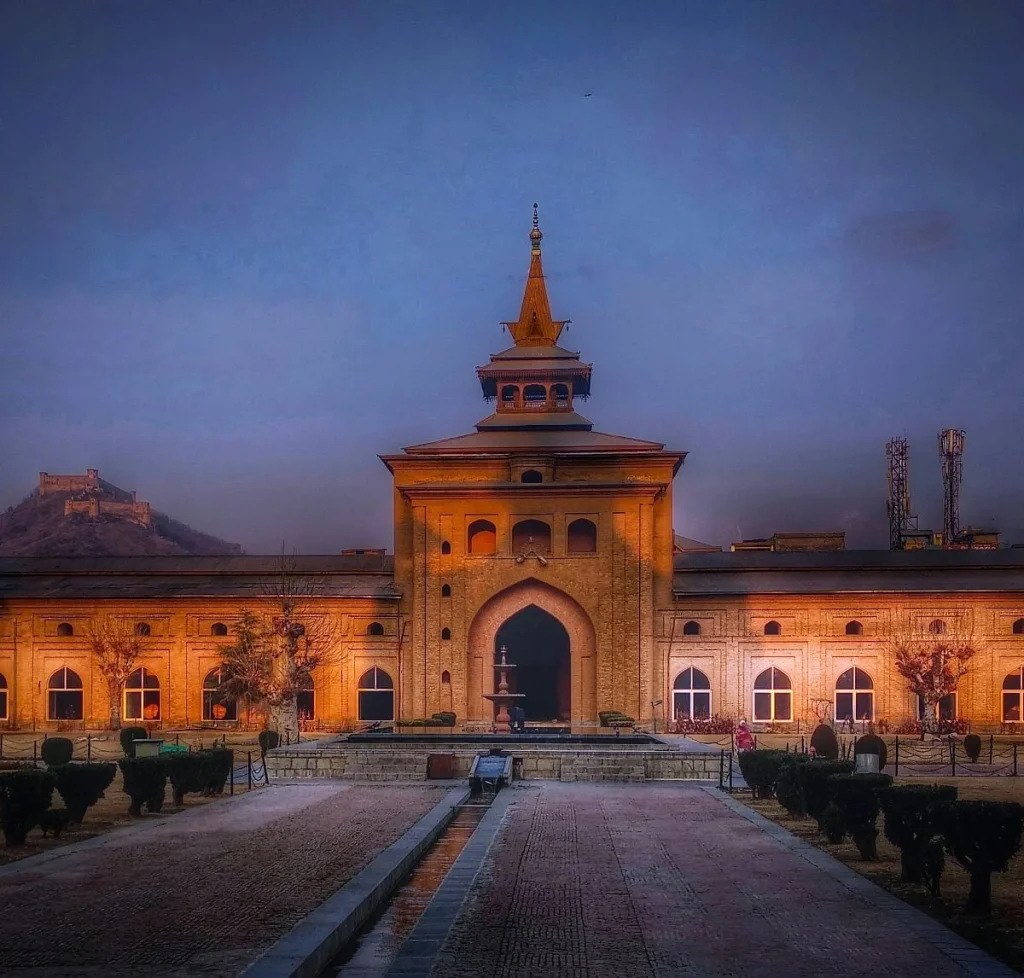
At a distance of 4 km from Srinagar Bus Station, Jamia Masjid is a religious mosque located in Srinagar, Jammu & Kashmir. Situated at Nowhatta, also called Downtown, Jama Masjid is the biggest mosque in Kashmir Valley and amongst the top places to visit during your Srinagar trip.
Lying in the heart of Srinagar city, Jamia Masjid happens to be one of the most ancient places to visit in Srinagar. This majestic mosque was built by Sultan Sikandar Shah Kashmiri Shahmiri in 1394 CE, under the orders of Mir Mohammad Hamadani, who was the son of Said-ul-Auliya Mir Sayyid Ali Hamadani, and was completed in 1402 CE.
Later on, Zain-ul-Abidin, the son of Sultan Sikandar, extended the mosque by adding a turret in the primary structure. This colossal structure has been damaged by fire thrice, but luckily, restoration work was carried out after each mishap to correct the damaged portions. The existing construction was erected by Emperor Aurangzeb after the fire broke out in 1672 CE.
The architectural style of the Jamia Masjid is inspired by the Indo-Saracenic style of architecture, and also bears certain similarities to the traditional Buddhist pagodas. The structure occupies a total area of 384 x 381 feet and is quadrangular in shape with four turrets. These are in the middle of each side and covered with pyramidal roofs. All of the turrets are interconnected by spacious halls, and a total of 378 wooden columns support the roof. The place can accommodate around 33,333 individuals at one time.
The entire structure is surrounded by wide lanes on all four sides and has a square garden in the middle. The entrance on the southern side of the Mosque comprises a recessed portico that further leads onto an inner courtyard. This courtyard is based on the traditional Char Bagh plan and has a tank in the center. The entire courtyard is made up of a pointed-arched, brick arcade.
Although Jamia Masjid is situated amidst busy markets, the architecture of this place leaves one surprised. Every Friday, the sacred Jama Masjid can be seen thronged by thousands of devotees to offer prayers.
Mughal Gardens: Nature and Architecture in Kashmir Monuments
The term ‘Mughal’ comes from a mispronunciation of the word ‘Mongol’ (an Arabic word). The Mughals of India were mostly ethnic Turks, not Mongolians. The Mughal Empire in India was founded by Babur (1526-30), a Central Asian ruler, descended from the Turco-Mongol conqueror Timur. The Mughal dynasty ruled the Indian sub-continent for over three centuries. They transformed the culture of the region together with the gardening style and left behind strong marks still seen today.
The Mughal gardens refer to a particular gardening style brought in by the Mughals following the Persian style of architecture. The style had a heavy influence of Persian gardens, especially the charbagh (four square) structure, rectilinear layouts within walled enclosures.
Nishat Garden
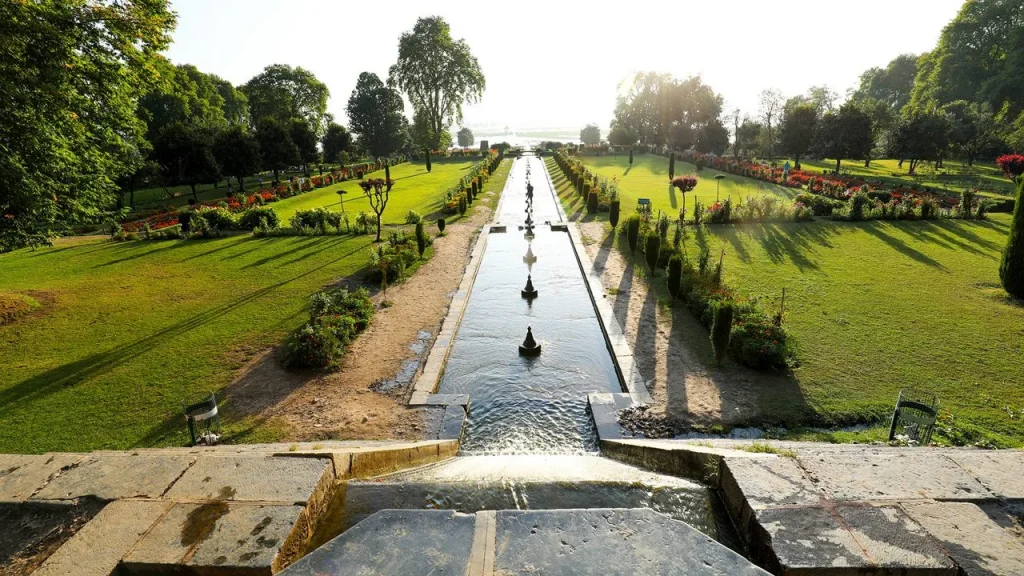
Nishat Bagh is a terraced Mughal Garden situated on the eastern side of the Dal Lake in Srinagar. This garden is also known as ‘The Garden of Bliss’ and has the Zabarwan Mountains forming its backdrop. The garden was designed and built in 1633 by Asif Khan, Brother of Noor Jahan.Noor Jahan. Nishat Bagh has 12 terraces representing the zodiac signs and offers splendid views of the Dal Lake and far distant snow capped mountain ranges of Pir Panjal.
Shalimar Bagh
Shalimar Garden or Shalimar Bagh in Srinagar is the largest Mughal garden in Kashmir valley, built by Mughal Emperor Jahangir in the year 1619 AD for his wife, Empress Nur Jahan. The term Shalimar comes from the Sanskrit language, which means “Adobe of Love”. This famous garden is situated on the right banks of Dal Lake, and the garden is also popularly called Shalamar garden, or Bagh, Faiz Baks, and Farah Baksh. This garden is an outstanding example of the Mughals in the field of horticulture.
Chashme Shahi
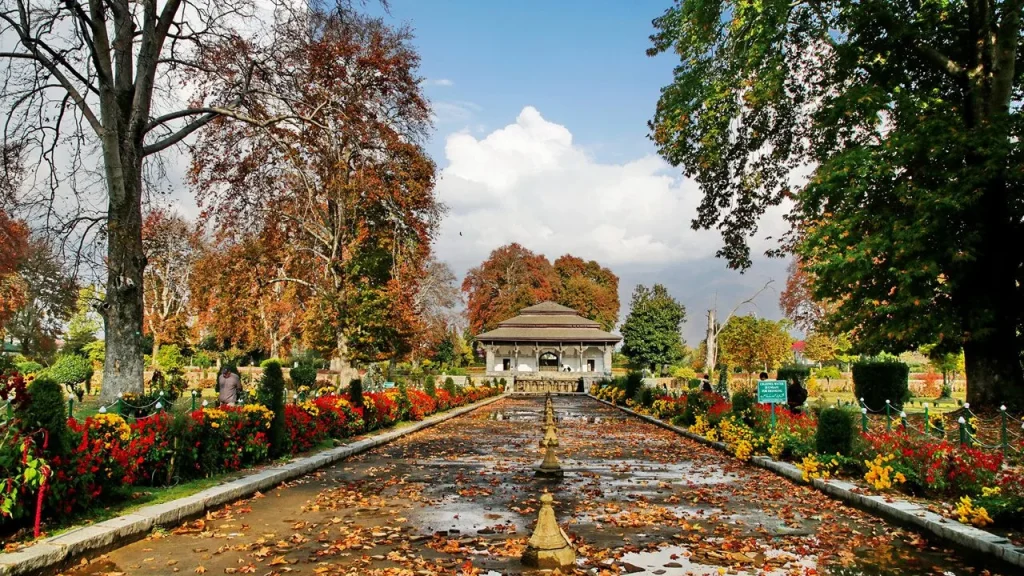
The smallest of the three Mughal Gardens in Srinagar is Chashme Shahi, ‘The Royal Spring’, and it is barely 108 meters long and 38 meters wide. However, it acts like a treasure house of natural beauty and splendor with its royal springs and perennial springs. This stunning garden was laid out by Mughal Emperor Shah Jahan in 1632 AD. The royal springs got their name from the springs discovered by a great female saint of Kashmir, Rupa Bhawani. This garden is renowned for the natural spring of refreshing mineral water. It has three terraces and a number of fountains which including an aqueduct and some waterfalls.
Naseem Bagh
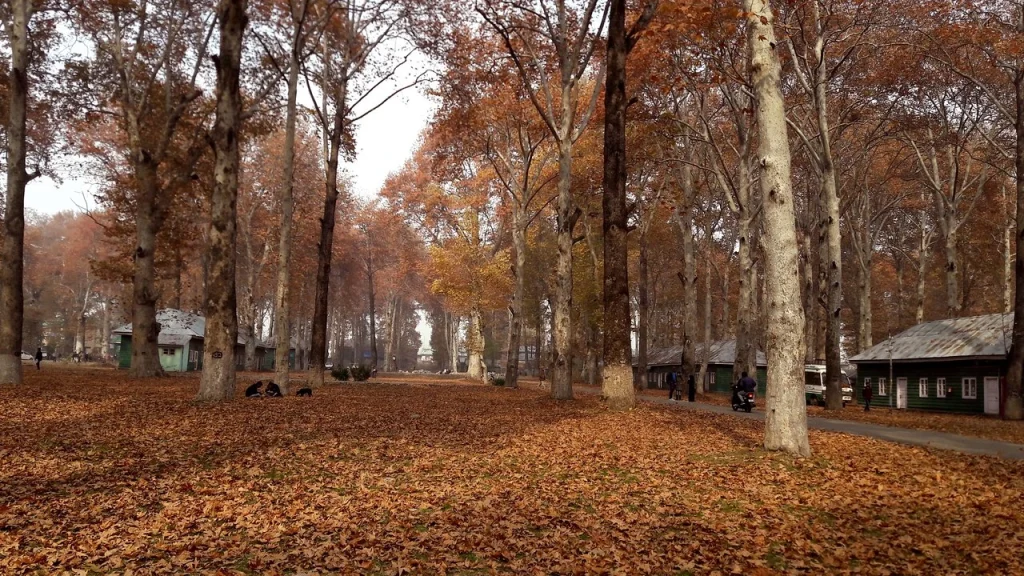
Naseem Bagh, the Garden of Breezes, is a grand Mughal-style garden. The garden was established by Jahangir as a pleasure resort for the royal family and their courtiers in 1586. On the waterfront of Dal Lake, there was a very peaceful spot perfect for relaxation and quiet contemplation.
As with most Mughal gardens, it has terrace levels, water channels, and acres of greenery. The Mughal summer capital is incomplete without Naseem Bagh — it represented imperial glory and the advanced engineering of its time.
Achabal Bagh
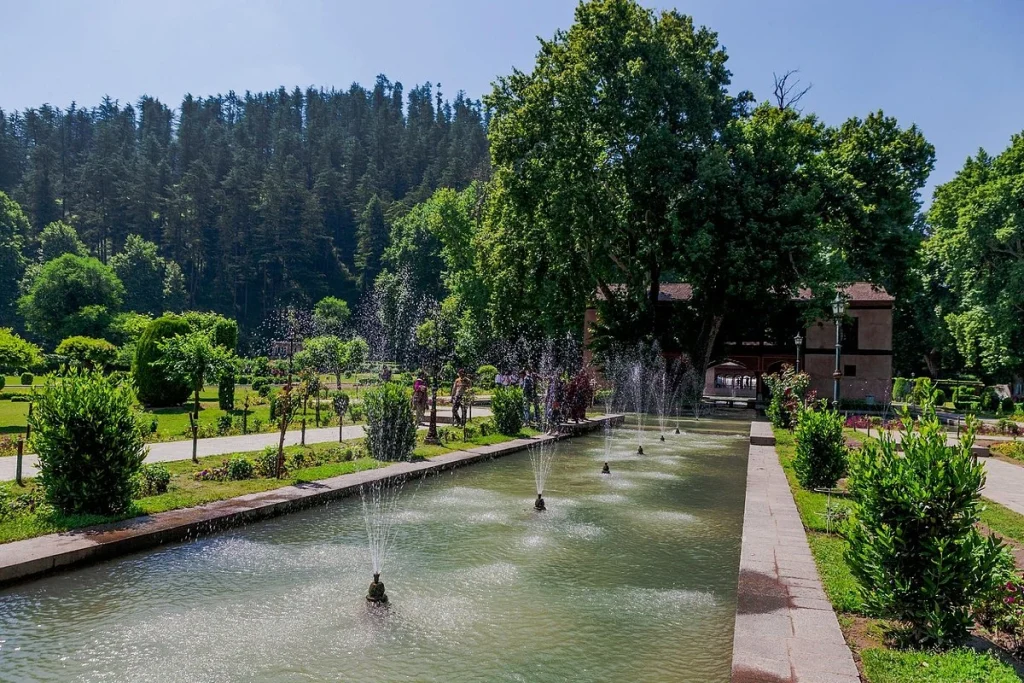
Achabal Bagh is located in the town of Achabal, about 69 kilometers southeast of Srinagar in the district of Anantnag at the southeastern end of the Kashmir Valley. The Himalayan mountains end in the Sosanwar hills, where Achabal lies. Considered one of the smaller Mughal gardens in the Vale of Kashmir, the site of Achabal Bagh may have formerly been a Hindu sacred site known as “Akkshavala”.
Verinag Bagh

Verinag on the road to Pahalgam is another spring of great importance and beauty with deep blue water, which also issues from the bottom of a high scarp of a mountain spur, and here again Jehangir built a pleasure garden and a summer house. An octagonal pavement has been raised around the spring by the Emperor Jehangir. The Emperor was infatuated with the beauty of Verinag to the extent that while breathing his last at Chakas village near Rajouri, he wished to be buried at Verinag.
Khanqah-e-Moula: Sufi Influence Reflected in Kashmir Monuments

Khanqah-e-Moula, also known as Shah-e-Hamadan Masjid and Khanqah (the First mosque/masjid in Jammu and Kashmir) located in the Old City of Srinagar, Jammu and Kashmir, India. Situated on the right bank of the river Jhelum between the Fateh Kadal and Zaina Kadal bridges, it was first built in 1395 CE, commissioned by Sultan Sikendar. It is one of the best examples of Kashmiri wooden architecture, and is decorated with papier mache.
The current mosque structure was constructed after destroying an ancient temple dedicated to the Hindu goddess Kali and a sacred Hindu site. It is believed by some that Sayyid Ali Hamdani had the temple of Kali demolished and built the present mosque with its material, and that a spring dedicated to Kali is still inside the mosque. The railing at the back of the mosque complex leads to a bright orange marking on the stone just below that suggests the foundation belonging to the destroyed Kali Shri temple.
Local Hindus were involved in various communal disputes and repeated altercations by 1942, agitating for the right to build a covered shrine adjacent to the Muslim shrine, which eventually led to a boycott of Muslim-owned shops by Kashmiri HindusIn ‘Eminent Personalities of Kashmir’, a book edited by a Kashmiri Hindu, Krishan Lal Kalla, mentions that according to Hindu belief, Khanqah was first the Kali temple.
The book claims: “When Hazrat Ameer Kabir returned from Makkah, he went into the temple and offered his prayers. After he left the place, it was found that he had left footprints on that stone plate where he had bowed before the God. That temple was converted at once into Khanqah-e-Moula.
Pathar Masjid: Mughal Stone Craftsmanship in Kashmir Monuments
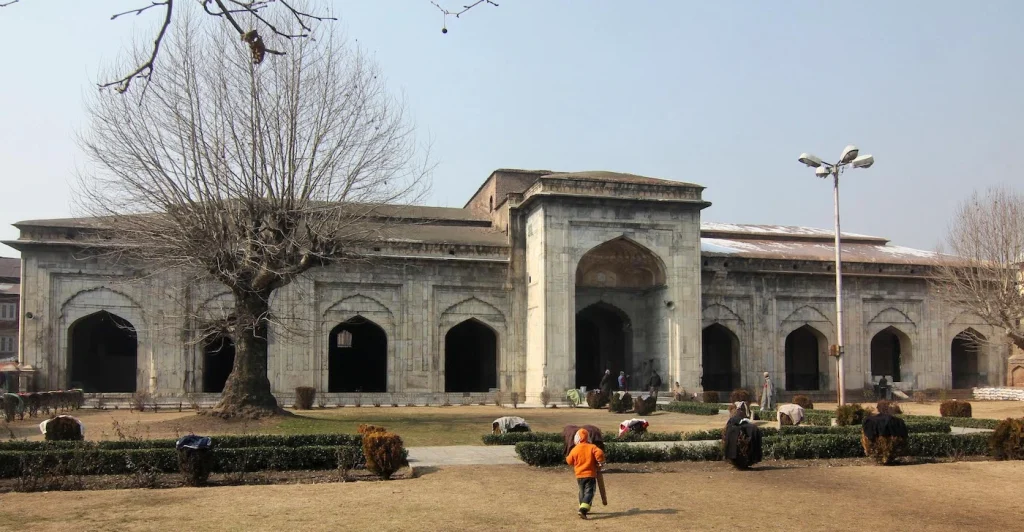
In the Nowhatta region of old Srinagar stands a somewhat dilapidated grey structure, seemingly out of place in a setting so close to the bustling capital of what is, by most accounts, a modern Union Territory in a modern nation. The fact that this structure is a mosque is not immediately apparent due to its stark architectural and material differences when compared to most of the mosques of the region.
It almost seems as if the shops, checkpoints, and barbed wires that have cropped up surrounding the mosque were deliberate attempts by the marching arrow of time to hide this medieval oddity from a world that reinforces modernity and embraces homogeneity. If one decides to explore this mosque more closely, however, the decorated arches, the lotus leaf carvings, and the domed roof reveal a centuries-long gripping tale of imperial ambition and accomplishment in the 17th century, along with neglect and conservation in the 20th and 21st centuries. The story of the Pathar Masjid (literally meaning the ‘Stone Mosque’)is one that deserves attention.
Pathar Masjid consists of a long arcade, located to the west of an enclosed courtyard. The façade of the mosque consists of nine arches, each of which is further enclosed in shallow cusped arches. These shallow arches, in their turn, are enclosed in rectangular frames. In addition, all these arches have been built horizontally, and this too is another distinction of this building.
Among these arches, the one in the center has a large portico. The plinth of the mosque is also very striking; one should stop to admire the lotus leaf coping on it. The spaces between the projecting cornice and the eaves are also decorated with a series of lotus leaves. These leaves are mostly carved in relief, but some of them have been pierced for ventilation purposes. The half-attached “bedpost” columns at the jambs of the entrance are also very remarkable.
Architectural Styles in Kashmiri Monuments: A Cultural Fusion
Mughal architecture is one of the most significant and enduring legacies of the Mughal Empire in India. Characterized by grandeur, intricate ornamentation, and structural innovations, it evolved through a blend of Persian, Timurid, Indian, and Central Asian influences. Among these, Persian architectural traditions played a particularly dominant role in shaping Mughal architecture, affecting its aesthetics, construction techniques, and urban planning.
The Persian influence on Mughal architecture can be traced back to the early Mughals, who were deeply connected to Persian culture through their ancestry, administration, and artistic inclinations. This influence was evident in the construction of mosques, palaces, gardens, and mausoleums, integrating Persian elements such as double domes, iwans (vaulted halls), charbagh (four-part gardens), calligraphy, intricate tilework, and symmetrical designs.
Conclusion
The need of the hour is a comprehensive plan that ensures regular maintenance, strict regulation against illegal encroachments, and promotion of these heritage sites on a global platform. By preserving these monuments, we not only protect our past but also create a source of pride and inspiration for future generations. The heritage of Jammu & Kashmir is a treasure that belongs to all of humanity, and we must act now before it is too late. Let us come together to safeguard the heritage monuments of this region and ensure that the stories, traditions, and architectural marvels they hold are preserved for the world to see and cherish.

